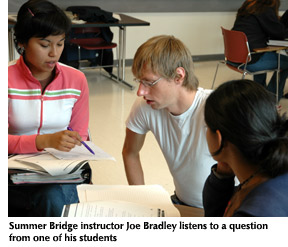|
 Claudia
Sanchez didn't want to take the chance of letting a learning disability
stand in the way of her college education so she chose to
attend Summer Bridge before beginning her freshman year this fall
at SFSU. A program of the Educational Opportunity Programs (EOP) at
CSU campuses, Summer Bridge was established in the mid-1980s to give
low-income, educationally disadvantaged students a better chance to
succeed at college. Serving 120 students each summer at SFSU, it includes
tutoring, counseling and classes designed to prepare students for the
demands of college life. Claudia
Sanchez didn't want to take the chance of letting a learning disability
stand in the way of her college education so she chose to
attend Summer Bridge before beginning her freshman year this fall
at SFSU. A program of the Educational Opportunity Programs (EOP) at
CSU campuses, Summer Bridge was established in the mid-1980s to give
low-income, educationally disadvantaged students a better chance to
succeed at college. Serving 120 students each summer at SFSU, it includes
tutoring, counseling and classes designed to prepare students for the
demands of college life.
Most students apply to the program because they need to strengthen
their knowledge and skills in math and English. They attend classes
four and a half days a week for six weeks. Introductory classes in
university writing and college math fill up the mornings, and tutorials,
counseling and seminars in college life round out the day.
"Many students who attend Summer Bridge at SFSU are often the
first in their family to attend college. The program allows these students
to get a handle on what to expect," said Ginger Yamamoto, EOP
director.
Teaching and learning styles are decidedly interactive. Students in
both the math and English classes work collaboratively in study teams.
Frances Kleven, an English instructor and academic coordinator of the
SFSU Summer Bridge program, said that she spends very little time in
class lecturing.
"I
believe that students learn best from each other," she
said.
Peer
instruction is encouraged in Joe Bradley's math class. "Learning
algebra is the same for everyone," he said. "We are just
a group of human beings struggling with the practice of abstraction."
The graduate student
in math and two-time ARCS (Achievement Reward for College Science)
scholar just completed his second year as a Summer
Bridge instructor. "I came back this year because I know we really
accomplish something here," Bradley said.
Maggie
Harrison, a graduate student in creative writing who has just
completed
her fourth year as a Summer Bridge English instructor,
agrees with Bradley. "The summer always begins with students who
are scared to death," Harrison said. "By the last class they
are a motivated group eager to engage on a college level."
"This
is one of the biggest things I have ever accomplished," Sanchez
said on her last day of Summer Bridge instruction. "I now see
myself as a college student and I know I can do college work."
Like
Sanchez, most Summer Bridge students said they are not likely to
forget their experience.
Some return to the program as counselors
or teachers. Jesus Magaña, an EOP counselor and coordinator
of SFSU's Summer Bridge program, is a product of the program at Cal
Poly, San Luis Obispo, where he earned his bachelor's degree in human
development and psychology.
"I came full circle," he said. "Most
of the things I heard from my counselors, I find myself passing on
to the students
here."
-- Denize
Springer
 |
